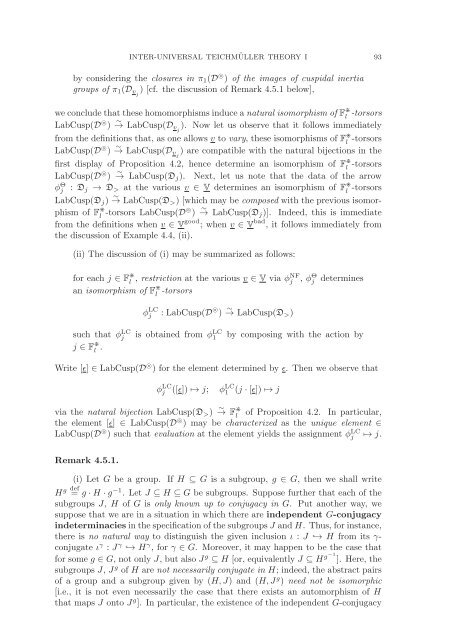Inter-universal Teichmuller Theory I: Construction of Hodge Theaters
Inter-universal Teichmuller Theory I: Construction of Hodge Theaters
Inter-universal Teichmuller Theory I: Construction of Hodge Theaters
Create successful ePaper yourself
Turn your PDF publications into a flip-book with our unique Google optimized e-Paper software.
INTER-UNIVERSAL TEICHMÜLLER THEORY I 93<br />
by considering the closures in π 1 (D ⊚ ) <strong>of</strong> the images <strong>of</strong> cuspidal inertia<br />
groups <strong>of</strong> π 1 (D vj ) [cf. the discussion <strong>of</strong> Remark 4.5.1 below],<br />
we conclude that these homomorphisms induce a natural isomorphism <strong>of</strong> F l -torsors<br />
LabCusp(D ⊚ ) → ∼ LabCusp(D vj ). Now let us observe that it follows immediately<br />
from the definitions that, as one allows v to vary, these isomorphisms <strong>of</strong> F l -torsors<br />
LabCusp(D ⊚ ) → ∼ LabCusp(D vj ) are compatible with the natural bijections in the<br />
first display <strong>of</strong> Proposition 4.2, hence determine an isomorphism <strong>of</strong> F l -torsors<br />
LabCusp(D ⊚ ) → ∼ LabCusp(D j ). Next, let us note that the data <strong>of</strong> the arrow<br />
φ Θ j : D j → D > at the various v ∈ V determines an isomorphism <strong>of</strong> F l -torsors<br />
LabCusp(D j ) → ∼ LabCusp(D > )[whichmaybecomposed with the previous isomorphism<br />
<strong>of</strong> F l -torsors LabCusp(D⊚ ) → ∼ LabCusp(D j )]. Indeed, this is immediate<br />
from the definitions when v ∈ V good ;whenv ∈ V bad , it follows immediately from<br />
the discussion <strong>of</strong> Example 4.4, (ii).<br />
(ii) The discussion <strong>of</strong> (i) may be summarized as follows:<br />
for each j ∈ F l<br />
, restriction at the various v ∈ V via φNF j , φ Θ j determines<br />
an isomorphism <strong>of</strong> F l -torsors<br />
φ LC<br />
j : LabCusp(D ⊚ ) ∼ → LabCusp(D > )<br />
such that φ LC<br />
j<br />
j ∈ F l .<br />
is obtained from φ LC<br />
1 by composing with the action by<br />
Write [ɛ] ∈ LabCusp(D ⊚ ) for the element determined by ɛ. Then we observe that<br />
φ LC<br />
j ([ɛ]) ↦→ j; φ LC<br />
1 (j · [ɛ]) ↦→ j<br />
via the natural bijection LabCusp(D > ) ∼ → F l<br />
<strong>of</strong> Proposition 4.2. In particular,<br />
the element [ɛ] ∈ LabCusp(D ⊚ )maybecharacterized as the unique element ∈<br />
LabCusp(D ⊚ ) such that evaluation at the element yields the assignment φ LC<br />
j ↦→ j.<br />
Remark 4.5.1.<br />
(i) Let G be a group. If H ⊆ G is a subgroup, g ∈ G, then we shall write<br />
H g def<br />
= g · H · g −1 .LetJ ⊆ H ⊆ G be subgroups. Suppose further that each <strong>of</strong> the<br />
subgroups J, H <strong>of</strong> G is only known up to conjugacy in G. Put another way, we<br />
suppose that we are in a situation in which there are independent G-conjugacy<br />
indeterminacies in the specification <strong>of</strong> the subgroups J and H. Thus, for instance,<br />
there is no natural way to distinguish the given inclusion ι : J↩→ H from its γ-<br />
conjugate ι γ : J γ ↩→ H γ ,forγ ∈ G. Moreover, it may happen to be the case that<br />
for some g ∈ G, not only J, but also J g ⊆ H [or, equivalently J ⊆ H g−1 ]. Here, the<br />
subgroups J, J g <strong>of</strong> H are not necessarily conjugate in H; indeed, the abstract pairs<br />
<strong>of</strong> a group and a subgroup given by (H, J) and(H, J g ) need not be isomorphic<br />
[i.e., it is not even necessarily the case that there exists an automorphism <strong>of</strong> H<br />
that maps J onto J g ]. In particular, the existence <strong>of</strong> the independent G-conjugacy
















